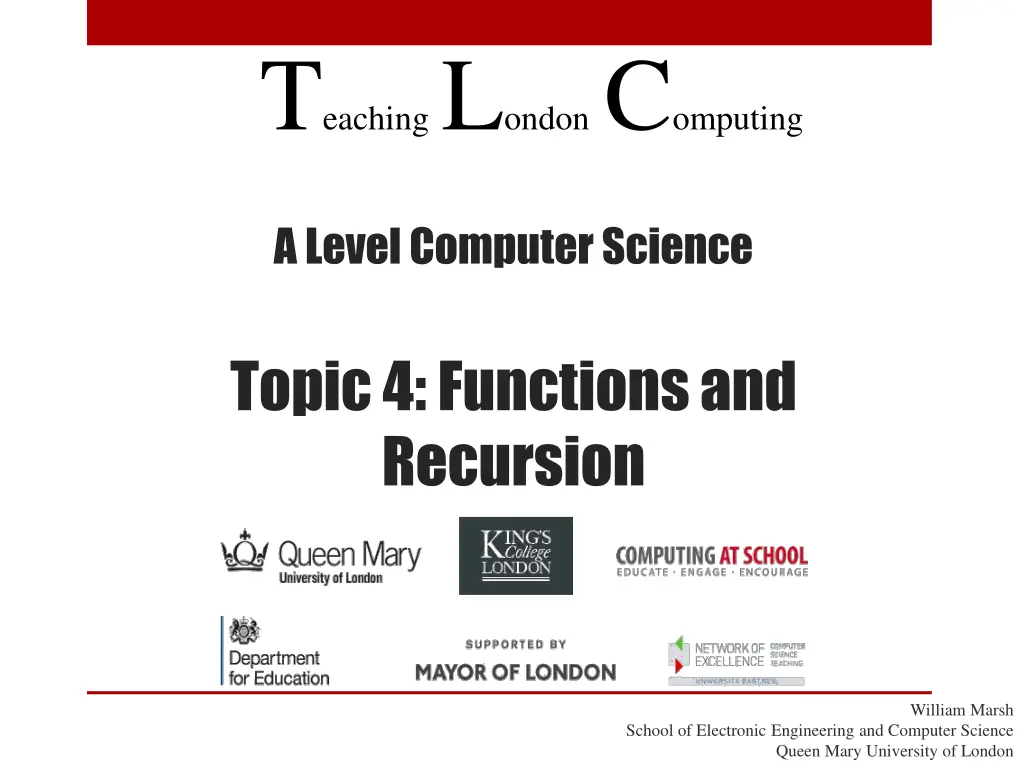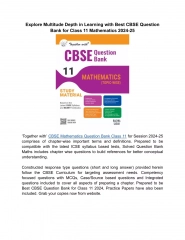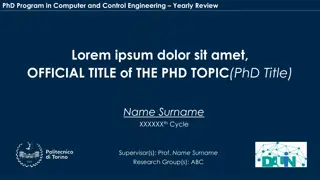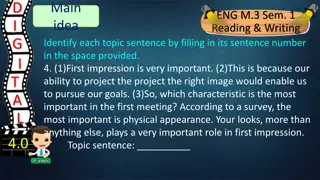
Understanding Functions and Recursion in Computer Science
Delve into the fundamental concepts of recursion and functions in computer science, exploring problem-solving techniques, the divide-and-conquer approach, and programming with recursion. Learn through examples like factorial calculations and recursive sorting, gaining insights into implementing recursive algorithms effectively.
Download Presentation

Please find below an Image/Link to download the presentation.
The content on the website is provided AS IS for your information and personal use only. It may not be sold, licensed, or shared on other websites without obtaining consent from the author. If you encounter any issues during the download, it is possible that the publisher has removed the file from their server.
You are allowed to download the files provided on this website for personal or commercial use, subject to the condition that they are used lawfully. All files are the property of their respective owners.
The content on the website is provided AS IS for your information and personal use only. It may not be sold, licensed, or shared on other websites without obtaining consent from the author.
E N D
Presentation Transcript
TeachingLondon Computing A Level Computer Science Topic 4: Functions and Recursion William Marsh School of Electronic Engineering and Computer Science Queen Mary University of London
Aims Recursion the idea Problem solving by divide and conquer Revision of functions Programming with recursion
Recursion Recursion is a fundamental idea
Example: Factorial 5! = 5 * 4 * 3 * 2 * 1 Factorial can be defined using factorial: Is defined as factorial(N) = N * factorial(N-1) But is this useful? 1. Base Case: factorial(0) = 1 2. Recursive case: factorial(N) = N * factorial(N-1), provided N > 0
Factorial Example 1. Base Case: factorial(0) = 1 2. Recursive case: factorial(N) = N * factorial(N-1), provided N > 0 factorial(4) = 4 * factorial(3) = 4 * 3 * factorial(2) = 4 * 3 * 2 * factorial(1) = 4 * 3 * 2 * 1 * 1
Recursion Define something in terms of itself Recursive case smaller instance of the problem Base case smallest instance Some algorithms are elegantly stated recursively Recursive implementation factR calls factR recursive call Divide and conquer
Binary Search (Again) Search a sorted array is E in the array? Base case: empty array or E found Recursive case: Compare E with the middle element If E smaller, search the left half If E larger, search the right half
Recursive Sorting Concept Split array in two halves, sort each half Combine two sorted arrays Single item sorted (base case) Two algorithms Merge sort Halve array merge two sorted lists Quicksort Partition array combine easy
Merge Sort Insight How could we share out sorting between two people? Half it and sort each half Merge the two sorted lists When there is only a single entry it is sorted
Merge Sort 17 31 52 19 41 34 76 11 Decompose 17 31 52 19 41 34 76 11 MAGIC Recursion 17 19 31 52 11 34 41 76 Merge 11 17 19 31 34 41 52 76
Merging Work done in the merge 11 34 41 76 Repeatedly select smallest 17 19 31 52 31 34 52 41 76 17 19 11
Quicksort Insight How could we share out sorting between two people? Choose a value V Give first person all values < V Give second person all values > V When there is only a single entry it is sorted
Quicksort Example 17 31 52 19 41 34 76 11 28 28 17 19 11 31 34 76 52 41 all >= 31 all < 31 11 17 19 28 41 34 52 76 19 28 34 41
Quicksort Description Choose a pivot value Partition the array Values less than the pivot to the left The pivot Values greater than the pivot to the right Repeat process on each partition until partition has no more than one value Work done in partition
Exercise 1.1-1.2 Demonstrate merge sort using playing cards. Can you make the use of recursion clear? Also try Quicksort
Properties Merge sort O(N log N) same as quick sort but extra space Stable http://www.sorting-algorithms.com/merge-sort Quicksort More efficient: O(N logN) Not stable http://www.sorting-algorithms.com/quick-sort
Functions To write recursive programs we need a good understanding of functions
Why Functions? Code organisation Functions allow code to be organised in parts Top-down development Code reuse The library Functions with parameters: existing code, your data Recursion
Elements of Functions Name and definition Issue: function must be called Parameters and return Issue: return versus print Local variables and scope Issue: where are the variables
Simple Functions def greet(): print("Hello") No parameters def greetByName(name): print("Hello", name) No return Issue A function must print or return Return and print are confused Suggestions Always use return Avoid print def greet(): print("Hello") return def greetByName(name): return "Hello" + name
Parameter & Return Name Parameter def fun1(p): p = p + 1 return p Return expression a = 1 b = fun1(a) print("argument a =", a) print("return value b =", b) Function call Actual parameter expression What is the result? Is variable a changed?
Exercise: 2.1 Discuss with another teacher Explaining definition versus call Explaining print versus return
Function Call Tree One function calls another main def doub(p): return p*2 call return quad def quad(p): d = doub(p) return doub(d) call return doub n = int(input("Number: ")) print("4 x", n, "=", quad(n))
Function Scope Scope: dictionary of variables p integer (6) def doub(p): return p*2 def quad(p): d = doub(p) return doub(d) p integer (3) d integer (6) n integer (3) doub code quad code n = int(input("Number: ")) print("4 x", n, "=", quad(n))
Global Variables A variable defined in a function is local Global variables can be read Update a global using 'global' Update g1 def f(): global g1 g1 = g1 + g2 Read g2 g1 = 1 g2 = 3 f() Globals instead of parameters Better to use parameters Worse to mix print("g1 =", g1) print("g2 =", g2)
Parameters and Assignment def fun1(thelist): thelist.append(41) myl = [2,3,4] fun1(myl) print("myl =", myl) Just like assignment a list: variable refers to the list parameter refers to the list What is the result? Is the list variable a changed? No global: reference is read
Exercise: 2.2-2.3 Implement shopping list functions.
Binary Search Function def BSearch(A, target): left = 0 right = len(A) while right > left: mid = (left + right) // 2 if A[mid] == target: return mid elif A[mid] < target: left = mid+1 else: right = mid return -1
Recursive Algorithms & Programs Algorithms described recursively Each stage like the whole Can be implemented iteratively Uses a loop Can be implemented recursively No loop Recursive function call
Factorial: Iterative and Recursive def factR(n): if n <= 0: else: Recursive call return 1 return n * factR(n-1) def factI(n): f = 1 for i in range(n,0,-1): f = f * i return f
Exercise: 3.1 Implement factorial using both recursion and a loop. Which do you prefer?
Binary Search (Again) Base case: empty array or element found Recursive case: search array search either left half or right half of array def findBRec(A, target, left, right): ... mid = (left + right) // 2 ... return findBRec(A, target, mid+1, right) ... return findBRec(A, target, left, mid)
Merge Sort Algorithm mergeSort(Array) L = length of Array if L <= 1 then it is sorted, return it else mid = L // 2 A1 = mergeSort(Array from 0 up to mid) A2 = mergeSort(Array from mid up to L) return merge of A1 and A2 Note: merge sort does not work in place need to copy data items
Merge Sort def mergeSort(A): L = len(A) if L < 2: return A m = L // 2 A1 = mergeSort(A[0:m]) A2 = mergeSort(A[m:L]) return merge(A1, A2) def merge(A1, A2): if len(A1) == 0: return A2 elif len(A2) == 0: return A1 else: if A1[0] < A2[0]: M = [A1[0]] M.extend(merge2(A1[1:], A2)) else: M = [(A2[0])] M.extend(merge2(A1, A2[1:])) return M
Merge Sort Example Print sorted lists, base case and after merge >>> mergeSort([23,21,54,17,62,25,19,11]) [23] [21] [21, 23] [54] [17] [17, 54] [17, 21, 23, 54] [62] [25] [25, 62] [19] [11] [11, 19] [11, 19, 25, 62] [11, 17, 19, 21, 23, 25, 54, 62] Base case Merge Merge Merge
Exercise 3.3 Complete the recursion implementation of binary search
Summary Recursion Way of thinking Equivalent to loops Many algorithms elegantly expressed recursively Recursive functions must understand functions






















